What is block fingering? It is a fingering method where you place groups of fingers down together. You place the primary finger PLUS any fingers of lower number down together. So if you play a 3rd finger, you place 1, 2, and 3 down together. If you play a 2nd finger, you place 1 and 2 down together.
I did not learn this method, and I do not teach or recommend it. I believe it slows down our playing, especially in chromatic pieces that do not maintain the same “tetrachord”, which is just a fancy word for a four-finger pattern. (I.E. a common tetrachord features a high 2, creating a half step between 2nd and 3rd finger.) Some pieces change back and forth between finger patterns, making block fingers very difficult.
My preferred method, and the one I teach in my online violin lessons featuring Suzuki Book 1, is “independent fingers”. I fondly refer to this method as as “spider fingers” because this violin fingering method is where each finger moves independently from the others, not in groups or “blocks”.
When using independent fingers, it is very important to do two things:
- Practice each finger separately to gain independent motion from the other fingers. This means each finger can move without affecting the others. It can lift up while leaving the others down, or it can stay down while the others go up. Furthermore, this must be done with a perfectly relaxed hand, without fingers “co-contracting” or fighting each other.
You will notice that ring finger is the hardest finger to master independent motion. This is because the ring finger does not have its own tendons all to itself. It shares tendons with either middle finger or pinky, making it naturally co-dependent on each of these fingers. But with practice, even ring finger can learn to move independently enough for violin playing.
- Learn to leave fingers in place on the fingerboard until it is necessary to move them. This is what I call “finger glue”, and it creates a very efficient left hand technique. This is often confused with “block fingers”, but it is very different. Block finger technique moves blocks of fingers together. Finger glue simply leaves each finger in place until such a time as moving it is required, either to play a new note, or to get it out of the way.
You can build finger independence by doing finger twister exercises such as my Exercises to Build Left Finger Independence, or you can even work on finger independence simply by doing finger lifts on a table top.
Below you will see photos of two exercises. One is simple finger lifts. The other is changing whole step/half step patterns by moving one finger independently from the others.
Exercise 1: Finger Lifts
Keep your fingers arched, and tap each finger 10 times, keeping the whole hand relaxed. The photos show 2nd finger lifting (Photo 1) and dropping (Photo 2).
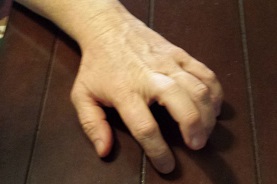 |
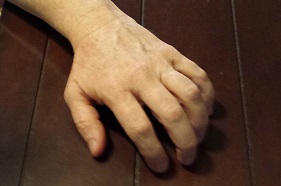 |
Exercise 2: Changing Tetrachords
Tetrachord is a fancy name for “finger pattern”. It basically is an arrangement of whole steps and half steps in our 4 fingers.
Place your hand on a table top with the fingers arched and relaxed. Practice sliding 2nd finger from touching 1st finger to touching 3rd finger. You are basically changing the tetrachord from a Low 2 to a High 2 position. (Photo 3 and 4)
Then try sliding 3rd finger from touching 2nd finger to touching pinky. This is changing the half step from between 2nd and 3rd to between 3rd and 4th. (photo 5 and 6)
Photo 3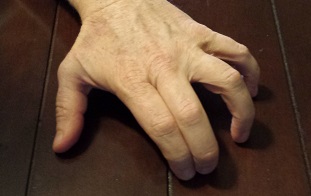 |
Photo 4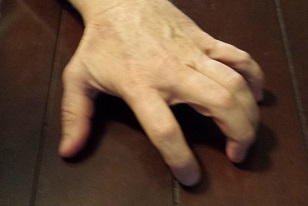 |
Photo 5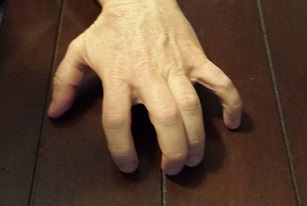 |
Photo 6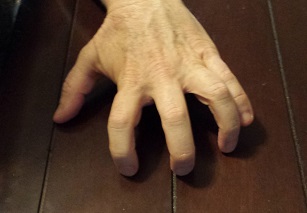 |
Also check out this page, left hand technique tips for violinists, for more of my tips and tricks to help you build left hand dexterity.


I am so happy to read this! My teacher always pushes me toward the block method. Being a piano player, this is very difficult to make my fingers do…and to make my brain do. Yay!
Thank you very much for the Tips and Exercises.
I am currently learning & practising Suzuki Volume 1. To me, Spider fingers proved to be of much more help than the rigid tetrachord.
Thank you!
Same here, Abhinav….I’m glad to hear your feedback.
I had the HARDEST time learning to relax my left hand….until I started using independent “spider” fingers rather than block fingers.
Keep up the great work! Violin will be a faithful companion for your whole life!
Thank you for the left-hand exercises and help. Seeing the pictures helped me quite a bit. I am using these and your clothespin exercises every day. I didn’t realize how difficult it is to move your ring finger separately. Will keep plugging along!
Block fingering master race! Jk!
Indeed it’s difficult and slows down the pace and adds more unnecessary requirement for a beginner whos struggling with many other important things so for most people, using block is reserved for later advance left hand exercises. I went through block exercises and it was well worth it. Exercises are fun and challenging and it improved my intonation among other left hand benefits. Try it out guys!
Nicola, it’s good to hear from you! I bet you are making huge progress!